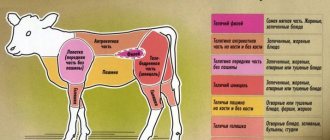In the first year of life, meat products must be present in the child’s diet. To build a strong, healthy body, a child needs protein and heme iron, which are found in sufficient quantities in meat. Introducing meat into complementary foods does not make sense until six months of age. Only from 6 months can you add ground meat products according to WHO recommendations.
Nutritional value of meat
From 6 months, the baby’s menu gradually expands, and in addition to mother’s breast milk, various “adult” products appear in it. Complementary feeding begins with vegetables or cereals, and then comes the turn of pureed meat. What meat to choose for complementary feeding, how and in what quantity is it introduced into the diet of a small child?
The importance of meat in complementary feeding of a child is determined primarily by the fact that with this product the baby can receive many of the substances that he needs for normal development. Porridge and vegetables alone cannot cope with this task. Let's first figure out why babies need meat? Of all the components, iron is the most important. By about six months of age, the baby’s reserves, created during the prenatal period, are gradually depleted. Of course, the baby continues to receive some amount of this element through breast milk even at an older age, but this amount will no longer be enough without additional introduction of iron into his body.
Those children who are fed formulas receive iron and vitamins introduced into the formulas during their industrial production. But such components from the formula are less absorbed than from breast milk. That is why for children who are bottle-fed, the risk of developing anemia is greater compared to infants.
Meat in a baby's complementary foods provides him with so-called heme iron. With cereals, vegetables, fruits, and milk, the baby can get non-heme iron, which is much less absorbed by the body. The process of absorption of non-heme iron by the human body is very labile, and therefore a baby who does not receive enough iron from food may eventually develop anemia, that is, the level of red blood cells and hemoglobin will decrease. This condition manifests itself as lethargy and decreased activity of the baby, poor appetite and insufficient weight gain.
The zinc and B vitamins included in the meat dish (B1, B2, B6 and B12) contribute to the adequate development of the baby, enhance its ability to resist various infections, forming the baby’s immune defense. Electrolytes calcium, potassium, phosphorus, magnesium provide physiological processes at the cellular level, being vital for humans.
Also, meat dishes perfectly train the little eater’s chewing apparatus and thereby develop his digestive system.
But, although the benefits of meat in feeding a child are obvious, we must remember that there are also pitfalls. Thus, meat contains saturated fatty acids, which are difficult for the baby’s gastrointestinal tract to digest. In addition, meat contains so-called extractive substances that stimulate gastric secretion and can cause overstrain of the digestive glands in a delicate child’s body.
This is why the timely introduction of meat complementary foods is so important for a child in his first year of life.
How to cook meat:
Step 1: Buy good quality turkey or rabbit meat, or lean beef, or the meat that was chosen for the first feeding.
Step 2: Cut off all the fatty pieces, cartilage and films are also removed.
Step 3: Place a piece of meat in a pan with water and cook for at least 1-2 hours, check the readiness of the meat. It is important to consider the size of the original product.
Step 4: 20 minutes after boiling, the meat broth is poured out and boiling water is poured in its place.
Step 5: Continue cooking the meat until done.
It is believed that if the broth is not used in preparing a dish for the baby, then there is no need to cook the meat in the secondary broth. Just cook the meat as usual.
When should meat be introduced into complementary foods?
For approximately the first six months, the baby should be fed breast milk or an adapted formula. And closer to six months, you need to carefully expand his diet, starting the introduction of complementary foods under the supervision of a pediatrician.
According to the recommendations of the World Health Organization, currently, a child of the first year of life, regardless of the type of feeding, breast or artificial, is recommended to introduce complementary foods from 6 months of age. So if a child’s introduction to the first courses of complementary feeding began at 6 months, then by 8–9 months the baby had already managed to adapt to vegetables and cereals. Now the baby’s diet can be expanded by introducing meat into complementary foods.
Experts advise offering meat purees to babies no earlier than 7–8 months, since at an earlier age the digestive system is not yet ready to digest meat. Yes, and protein can create excess stress on the kidneys or cause an allergic reaction.
According to indications, for example, in the case of severe anemia, weight loss, lack of B vitamins, the pediatrician may recommend expanding complementary feeding with meat purees a little earlier, from 6 months. In addition, children growing up on artificial feeding need an earlier introduction of meat complementary foods.
The time for introducing meat also depends on what kind of meat is introduced into complementary foods: homogenized “canned” meat purees can be given from 7–8 months, but with homemade meat purees it is better to wait until 9–10 months.
Despite the fact that the main recommendations are given by the pediatrician, you can also understand whether the time has come to introduce meat into complementary foods. A toddler is ready to eat meat if he eats porridge and vegetable puree without any problems, he has no problems with stool, and he accepts a new product with pleasure and interest.
Rules for first introduction
In order for the new food to be beneficial and liked by the baby, you should adhere to the following rules:
- The boiled meat product must be ground well. Kitchen aids make it possible to make purees smooth and smooth.
- You should mix the meat puree with your baby’s favorite food – breast milk, formula. In the future, it can be added to porridge or vegetable puree.
- The first portion is ½ teaspoon, it is better to give it in the morning, half an hour before the main meal. In the future, if there are no reactions, the norm is increased by ½ teaspoon per day.
- The puree is prepared fresh every day and served warm. Do not store the finished dish in the refrigerator.
- You need to accustom your baby to different types of meat one by one, maintaining consistency and not mixing different varieties.
- At 10 months, your baby can be given meatballs. The meat is ground raw and boiled. Many children with teeth enjoy chewing small pieces of meatballs, developing chewing functions and strengthening their gums.
It is necessary to correctly introduce meat into the diet, gradually accustoming the baby to different types of products and monitoring digestive reactions and possible allergic manifestations. Over time, for many children, meat products become the most beloved and desired.
How to properly introduce meat into complementary foods
The rules for introducing meat into complementary foods are similar to the rules for introducing infants to any foods. Meat can only be offered to a healthy child, when he is in a good mood and hungry. It is better to postpone introducing this dish if your baby has recently had a vaccination or it is very hot outside.
First, offer your child homogenized and one-ingredient pureed meat. Give it warm and always before you offer your baby breast milk or formula.
The baby is gradually accustomed to the full volume of meat puree. A child's acquaintance with a new product begins with an incomplete teaspoon. Gradually, over the course of two weeks, the volume of meat feeding is increased to 30 g per day, and by the end of the 9th month the child should receive 50 g of meat puree daily. If you have not noticed any changes in your baby’s condition, then gradually increase the portion size to the recommended age-specific daily dose (at 7–8 months – 30–40 g, by one year – 50–70 g).
Like any complementary food, meat puree is offered to the baby before dairy food (breast milk or formula), since after the usual diet the baby most likely will not want to try something unfamiliar, and even unsweetened.
The introduction of meat food into a child’s diet is not combined in time with the introduction of other new products, so that if a reaction to a new type of food occurs (for example, an allergic rash), it is easier to recognize the cause. Meat puree is usually mixed with vegetable puree. In this form, the baby perceives it more readily.
For older babies, you can offer steamed cutlets and meatballs.
Which meat puree to choose for complementary feeding?
| Firm | Advantages | Flaws | Price |
| Tema (Russia) | Large selection of food for children over 6 months, affordable prices | Contains salt, a small proportion of meat in the composition | from 38 rubles (100 g) |
| Agusha (Russia) | High quality and natural composition, easy to open, rarely causes allergies | Too liquid consistency, inconvenient packaging | from 43 rubles (80 g) |
| Babushkino basket (Russia) | Safe natural composition without starch, easily digestible, delicate consistency | Only for children over 8 months | from 57 rubles (100 g) |
| Gerber (Switzerland) | Excellent for first feeding, high quality, delicate and pleasant consistency | Small packaging, high price | from 89 rubles (80 g) |
| Semper (Spain) | Variety of types for 6, 7 and 8 month olds, low cholesterol | High price | from 78 rubles (80 g) |
| FrutoNyanya (Russia) | Wide range of food and affordable prices | High starch content, too thick consistency | from 39 rubles (75 g) |
| Heinz (Italy) | A wide selection of purees for complementary feeding, delicate consistency ideal for first feeding, natural composition without salt and gluten | High price | from 50 rubles (120 g) |
| Hipp (Germany/Hungary) | Hypoallergenic product without starch and gluten, low sodium content, contains iodized salt, normalizes stool | Contains onions, so is only suitable for children over 8-9 months, high price | from 80 rubles (80 g) |
The brands of baby food listed above comply with accepted Russian and international standards.
Therefore, it is safe for small children. Whether one company or another is suitable for a baby depends on individual characteristics and needs. If your baby refuses complementary foods or shows signs of allergies, try changing the brand of food. What to do if a child does not eat complementary foods, see the link https://vskormi.ru/breast-feeding/rebenok-ne-est-prikorm-chto-delat/. Subscribe to our VKontakte group
What meat to choose for complementary feeding
Rabbit and turkey are the optimal meats for first foods. Such food contains valuable proteins and mineral compounds necessary for toddlers, but at the same time, both rabbit and turkey are less allergenic and are easier for babies to digest than other types of meat.
If your baby eats rabbit or turkey puree with appetite and without negative consequences for a whole week, then you can introduce him to some other types of meat - veal, beef, chicken.
As the child grows, make changes to the consistency of the meat dish: at 9–10 months, offer him a meat soufflé, and a one-year-old gourmet who is curious about adult food can be treated to meatballs or steamed cutlets.
It is best to give meat to a child for lunch, combining it with vegetables, since meat and vegetables harmoniously complement each other - both in terms of nutritional value and in terms of taste. Zucchini, pumpkin, broccoli, cauliflower, green peas, and carrots go especially well with meat. Some cereals are the same compatible partners - oatmeal, rice, buckwheat.
Until fish appears on the baby’s menu (after 10–11 months), meat should be given daily, once a day.
What type of meat is best to start with when first feeding?
Different types of meat differ in the content of nutrients, the structure of muscle fibers, the ability to cause allergies, and the characteristics of digestion in the gastrointestinal tract. Based on this, the types of meat to start complementary feeding are selected. The first on the recommended list of animal products are rabbit and turkey. These types of meat products have fine fibers, are digested better than others, and contain a low amount of fat. These types of meat practically do not cause allergies and are considered dietary.
Next in terms of beneficial qualities is chicken, which is also suitable for early complementary feeding. The reputation of this valuable product has been greatly damaged by the methods of raising chickens on an industrial scale. Therefore, for a child, for early complementary feeding, only poultry raised by farmers in natural conditions is suitable.
Beef contains an excellent set of amino acids and vitamins, and is very useful for children with anemia and lack of hemoglobin. Coarse fibers make it less useful for early complementary feeding.
Pork, goose and duck meat, lamb are considered the fattest, and are not used for first feeding. It is better for the child to get to know them last. Fatty poultry should be eaten after 3 years of age. Pork and lamb can be given to a baby after one year. Thus, where to start introducing meat components into the diet depends on the parents. Turkey, chicken, and rabbit are suitable for first feeding. Let us remind you that the meat must be of good quality, homemade.
Weaning Meat: Canned Food or Cooked Meat?
Of course, everything that is used to feed the baby must be safe for his health. Industrially produced meat purees are prepared only from high-quality meat that has undergone strict hygienic control and meet all standards for baby food.
But if the mother decides to prepare meat puree for the baby herself, then she needs to be very careful when choosing meat. In this case, she must be confident in the freshness of the purchased product and its safety from the point of view of sanitary standards. If there is no such confidence, then it is still better to offer the baby industrially produced products.
In addition, canned meat and homemade food usually differ in the degree of grinding of the product. Industrially produced meat purees are prepared taking into account all the characteristics of the child’s body. For each age group, the puree has a certain degree of grinding. Products for little ones are usually homogenized purees that are easy to digest. As the baby grows, he can be offered meat puree with larger dietary fibers, this prepares the child for subsequent digestion and absorption of solid food. When choosing canned meat products, you should pay attention to the expiration date, the presence of additional components in the canned food and the recommended age of the baby at the time of introducing the product (indicated on the jar). Ideally, there should be nothing “extra” except meat and water in the industrial production of canned food. Thus, preservatives, genetically modified products, and soy protein are completely unsuitable components for feeding infants. It should be borne in mind that some manufacturers use rice flour and starch as thickeners.
At home, it is more difficult to grind meat for complementary feeding to a completely homogeneous state, so the baby, as a rule, requires more effort to digest it. Here's a quick step-by-step guide to making meat puree at home:
- Rinse fresh meat thoroughly under running cold water;
- remove fat and tendons;
- put the meat in cold water and cook for 5 minutes from the moment the water boils, then drain the water and pour in fresh cold water (it is better to use filtered or bottled water when feeding babies);
- cook until done (cooking time depends on the type of meat; beef and veal are cooked for about two hours, chicken and turkey will be ready in 40–60 minutes);
- Cut the finished meat into pieces and grind in a blender.
It is important to remember that it is not recommended to use salt to prepare meat puree for up to a year.
Making your own meat puree
Store-bought purees are more convenient. They are already prepared and canned, just open the jar, heat the product and feed the baby. Many parents prefer to prepare complementary foods from meat themselves.
To do this, you can use a simple recipe:
- You will need a small piece (20-30 g) of dietary meat suitable for feeding infants;
- The meat should be washed well, remove excess parts, leaving only the pulp;
- Grind the product in a meat grinder; it is not recommended to use a blender so that the pieces are not too small;
- Boil the resulting pulp until tender;
- Pass the broth along with the ground meat through a fine sieve.
The indicated volumes are per 1 serving for the first stages of introducing complementary foods. You can make more puree and freeze it for later.
Heme and non-heme iron: what is the difference?
Heme iron:
- Contained in meat and fish.
- Absorbed better than non-heme iron (the average absorption of heme iron from meat is about 25%).
- Other nutritional components have very little effect on the absorption of heme iron.
Non-heme iron:
- Contained in all other foods and makes up the majority of dietary iron.
- Absorption of non-heme iron is much lower than heme iron (8–10%).
- The absorption of non-heme iron depends on its solubility in the intestine, and this, in turn, is determined by the composition of the food eaten at one meal.
It is important to understand that products containing non-heme iron cannot be compared with meat products in terms of its bioavailability (ability to be absorbed in the child’s body).
What is a meat allergy?
Some kids suffer from allergies from an early age. It usually concerns certain types of products, including meat.
Complementary feeding should be organized based on the following rules:
- Rabbit and turkey cause the least number of reactions. The products are classified as hypoallergenic. It is recommended to start feeding with them.
- If a child reacts to cow's milk, an allergy to beef and veal cannot be ruled out. You should refrain from eating them.
- If there are negative effects on chicken eggs, you should refuse chicken.
You should start feeding your baby meat products in the morning, monitoring skin and other manifestations. If reactions occur, stop complementary feeding and seek advice from a pediatrician. The assortment of meat is large, you can choose a type of product that is not dangerous for your baby and introduce it gradually. There is no need to give up meat.
Diet difficulties
Pediatricians know the most common problems that arise when introducing meat complementary foods.
If your baby refuses an unusual taste, don’t insist or force it. It’s better to add meat to his favorite vegetable purees or porridges.
If the baby doesn’t like the taste of meat, then perhaps he simply hasn’t found his “favorite” yet. Offer him a different variety - what if the little gourmet prefers veal to rabbit?
Sometimes a situation arises when an older baby refuses cutlets or meatballs because he is too lazy to chew or cannot cope with their consistency. In this case, prepare dishes for him from very tender minced meat of the highest quality.
Helpful information
Before preparing meat for the first complementary feeding, you should consult your pediatrician. The doctor will tell you whether your baby can try new foods. It is strictly forbidden to add spices to any types of complementary foods. Puree from meat products does not taste very pleasant without salt, but it should not be added under any circumstances. Parents often find it helpful to keep a food diary for their baby. This makes it easier to track the number of new foods, the frequency of introducing new treats, and the amount of complementary foods eaten. It is recommended to increase the dose of water that the baby drinks immediately after introducing meat food. If the baby does not eat meat supplements, do not insist. It is enough to take a break for 7 days and then offer the puree again. It is important to carefully, without coercion, accustom your baby to meat. A child’s body urgently needs animal proteins; without meat products, a child cannot grow up strong and healthy. Proteins of similar quality are found in other products, but no food can completely replace meat.
Doctor's advice
Be prepared for the fact that in the first days of introducing meat into complementary foods, the child may experience discomfort in the tummy, and, accordingly, he will behave restlessly. In this case, you can reduce the portion. And, of course, mothers need to remember that the introduction of complementary foods does not always go smoothly and the child may initially refuse the new taste. But you must be persistent and patient: if the baby does not want to try meat puree for the first time, offer it every day again and again until he understands that there is nowhere to retreat. Just don’t do it forcefully, just insist gently.
Cook at home
Pediatricians do not insist that mothers feed their babies exclusively with ready-made baby food. But if you decide to treat your baby to homemade meat puree, then you need to follow a few simple rules:
- Choose high-quality lean meat from farmers or stores you trust.
- Free raw meat from bones, veins and fat, then cook it for at least one and a half hours.
- Grind the boiled meat thoroughly in a blender or using a meat grinder (the standard recommendation is to grind the meat 2 times).
- To make the puree thinner, you can add breast milk or formula.
- Please note that salt and spices are not added when cooking meat for baby feeding.
- Only serve freshly prepared meat puree to your baby.
Choosing pureed meat for your baby in the store
Many parents prefer to use ready-made meat purees for their children.
This not only saves time, but also has a number of other advantages:
- the quality of meat has been checked by manufacturers and sanitary services;
- the consistency of the meat component is selected in accordance with the age needs of the child - homogenized, pureed, chopped or pieces;
- the composition is supplemented with vitamins and microelements;
- healthy combinations with cereals and vegetables were chosen.
You need to choose a product taking into account age, composition and manufacturer, giving preference to trusted companies that have proven themselves in the market.
Compound
The components of the composition are selected taking into account the age-related needs of the body and permitted products. In stores you can find canned meat from beef, rabbit, and other types of meat that are healthy and necessary. It is often impossible for mothers to find such meat in raw form. This sometimes attracts parents to buy ready-made purees.
Canned food for babies includes:
- vegetable oil:
- starch;
- cereal;
- water, to give a delicate consistency;
- vegetables;
- spices, for taste.
The content of fat (about 10%) and protein (10-15%) corresponds to consumption standards for each age.
Popular brands
In Russia, canned meat purees from the following companies are popular with parents and children like them:
- Gerber. Many types of products are produced from different types of meat and poultry, with the addition of vegetables, vegetable oils, and cereals. Enriched with Omega 3.6. USA, Europe.
- Agusha. Produced in Russia, meets domestic safety standards.
- Grandma's basket. Winner of many baby food competitions, including Test Purchase.
- Subject. Another domestic product. A budget option for canned food for children is of good quality.
- Heinz. Very gentle, ideal for first feeding.
Many types of baby food are expensive. The quality of Russian food for babies is no lower, so you can choose domestic budget brands. It is worth recalling that genetically modified products have long been allowed in the United States; in Europe, with a huge population density, there are hardly any ecologically clean areas and products. Rather, these are advertising gimmicks from manufacturers.
Expert opinion
Natalia Volodina, pediatrician at the Medic clinic
From a medical point of view, vegetarianism for children is unacceptable, since the child will not receive the amount of protein necessary for growth from plant foods. Also, without meat, he will not receive enough iron, which is important for the full development of all organs and systems.
The stage of introducing meat complementary foods begins at 7–8 months, after the baby is introduced to vegetable and fruit purees, cereals and juices.
Meat complementary foods should be introduced by mixing it with a product that your child already knows and loves well: most often these are vegetables, but it can also be porridge. If an allergic reaction or problems with stool do not appear, then increase the amount of meat puree over 7–10 days.
But remember that before the age of two, children should not be given broth in which meat was cooked, and especially bone broth, since it is a concentrate of extractive substances and fats, and such food deals a very powerful blow to the child’s pancreas and liver. Lamb should not be introduced into a child's diet, as it contains refractory fats that are undesirable for his digestive system.
The benefits of meat for babies
In the first six months of life, the child feeds on mother's milk or formula. Breastfed babies have enough iron and amino acids. After six months, the child will be able to obtain the same elements from fermented milk products, fish and poultry.
Complementary feeding in the form of meat, at the same time, provides certain benefits to the baby:
- Natural meat is an important source of protein and amino acids. Partially, such elements cannot be obtained from natural plant products, only with the introduction of artificial vitamins.
- Iron, phosphorus, zinc, and copper of animal origin are much more easily absorbed by the human body than the same elements obtained from plant foods.
- Meat products contain vitamins and minerals necessary for the growth of a strong, physically strong body.
- For older children, the dense fibrous structure of meat products helps develop chewing skills.
- The presence of meat complementary foods in the diet of a baby under 1 year of age is mandatory.










